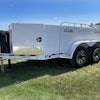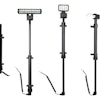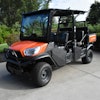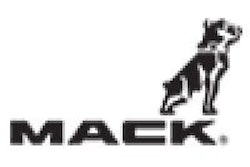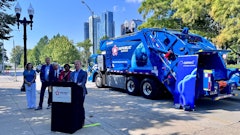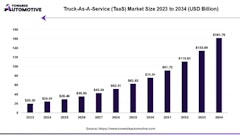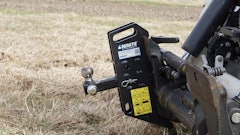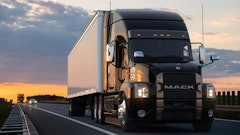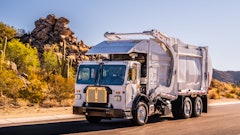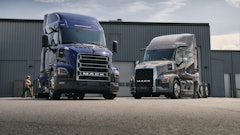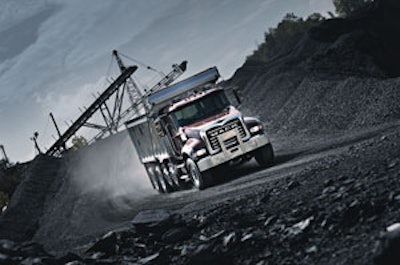
Specing a truck for a vocational application can be a daunting task. Get it wrong and it will definitely impact the bottom line.
Customers typically start by getting a truck and trying to make it work often with disappointing results, notes Bob Johnson, director of Fleet Relations at the National Truck Equipment Association. Johnson understands the topic well. He holds a mechanical engineering degree, has 40 years of experience in utility fleet and heavy equipment maintenance and design and currently conducts seminars for customers on how to spec vocational trucks.
Both Johnson and David McKenna, director of powertrain sales and marketing, Mack Trucks Inc., agree that the first step is to define the exact vocational application.
For instance, a dump truck that is used primarily on a jobsite or largely off road would be specd very differently than a dump truck that operates mostly on maintained roads, says McKenna, yet both vehicles may be tasked with hauling similar loads.
Define limitations
After you have defined the application, you need to identify the limiters, says Johnson. These include restrictions on the overall length and weight of the truck, as well as the grades and terrain it will encounter. Are there any unusual items that will constrain the vehicle? he asks. Does it have an unusually steep grade that it has to climb? Will there be a certain size garage door someplace?
Topography can play a major role in the specs required. Midwest dump trucks may operate mostly on relatively flat ground, whereas a dump truck in West Virginia is going to experience significant grades and tight twisting roads, says McKenna. You need to examine the Gross Vehicle Weight Rating (GVWR) in each of these applications and determine the best solution.
When working in an on/off-road environment, you need to take into account both the off-road and on-road criteria. It is extremely difficult to design an on/off-road truck without some compromises, says Johnson. It is just deciding which compromises you can live with the best.
This involves looking at more than simply the duty cycle. A lot of people make [the mistake of] saying my duty cycle is 70% off road, [so] I will tailor the truck for that, Johnson states. But that 30% on road may involve a 100-mile route. Therefore, the ability to get over the road quickly is a critical factor.
Always start with the application and identify your functional requirements, he advises. Once you have defined the limitations, you know what the dimensions and weight are going to be. Then you can spec a truck for the application.
Also factor in running the correct components at rated capacity, says Bryan Howard, vocational sales manager, Daimler Trucks North America. For instance, if a customer took a standard delivery truck chassis and threw a dump bed on it to be used off-road 75% of the time, he is probably going to have some suspension issues, he points out. There are major design differences between on-road and off-road suspension packages, even if they are both rated for the same GAWR.
If the customer properly specs a truck with the correct components for the application, appropriately loads the chassis and operates it responsibly with proper servicing, he adds, then we would expect to see good component life and a good service life even when operated at near capacity much of the time.
Spec the
powertrain last
The drivetrain solution is also determined by the defined application. An off-road, low-speed, high GVW truck will require much lower transmission and rear axle ratio gearing, and a high torque rise engine with plenty of peak torque, than a chassis that will see highway speeds most of the duty cycle, says McKenna. In that case, higher rear axle ratios and higher horsepower are required.
The first step is to determine the weight of the truck and the number of axles required. Then, you need to define the performance criteria starting and road gradeability under maximum load, surface conditions (soft dirt, mud, sand), how fast you want the vehicle to go things of that nature, says Johnson. Then, it is pretty much a set process. You calculate the required horsepower and the required torque.
Once you have the engine selected based on the declared horsepower and torque, and determine the engine operating speed from the performance charts, you can select the final drive (rear-end gearing) to get the road speed required, says Johnson. Next, you can calculate transmission requirements.
A lot of people who have not been in this business a long time are really not aware of these procedures, says Johnson. Dealers will plug numbers into their computer programs and tell you this is what you need. Those programs do a very good job. The problem is they do not give you criteria to purchase from another manufacturer. It makes it hard to compare two or three brands. Its a matter of first determining what the truck is going to be, then defining the performance requirements, the engine, the rear end and, finally, the transmission.
For an on/off-road truck, these calculations need to be computed twice. You need to do these calculations for highway performance and off-road performance, says Johnson. Off-road gradeability might be 30%, but the maximum speed might only be 20 mph. On road, I might need 15% gradeability, but I need a road speed of 65 mph. In extreme situations, you may have to get a dual-range transmission.
Fortunately, most current engines have such wide torque bands, and with the gradeability achievable with many of the transmissions currently available, you can frequently get all you need without having to go to a dual-range transmission, he adds. That is good, because it is less maintenance and costs less [for a traditional transmission]. But you have to go through the process.
Depending upon the most important vehicle performance objectives, a powertrain can be selected that favors specific objectives, or that delivers a balanced all-around performance, says Dave Siler, marketing director, Detroit Diesel Corp. Specing for fuel economy should drive down the operating speed of the engine through thoughtful selection of drivetrain components and ratios. Specing for power and responsiveness should drive up the gradeability and startability of the engine/drivetrain combination.
Regardless of the specing objectives, the vehicles and drivers ability to do the job efficiently over the life cycle is the ultimate goal, he adds. Todays diesel engines produce more torque across a broader range of speeds than ever before. This simplifies the vehicle powertrain spec and allows the engine to do more of the work than before.
Avoid over-
specing engines
In todays world, there is a huge tendency to over-spec power, Johnson comments. Owners are going by past experience, and the technology has changed a lot. Engines have more horsepower and more torque. They have a larger torque band.
This tendency to go with what worked last time can mean you end up with a truck that is overpowered. It is going to cost you more money. It is probably going to add weight to the vehicle. It is probably going to burn more fuel, says Johnson.
The downsides to specing more torque and horsepower than required for a given application are a reduction in fuel economy, greater stress on the vehicle and its components and higher up-front costs, adds Siler. Its important to understand the vehicles expected performance, as well as the expected life-cycle costs, in order to determine the best possible specification for the job.
Its also important to keep performance expectations in check. Just because a certain engine can pull a particular grade at 65 mph doesnt mean it is the best choice for your application, says Johnson. Ask yourself if that criteria is really important. Can you live with going up that long grade at 55 mph and putting a smaller, lighter, more fuel-efficient engine in your truck?
On the other hand, you do need to leave a little margin. You never want to run an engine at maximum horsepower and maximum rpm, cautions Johnson. When you design your powertrain, you want to back the engine at least 5% off of its peak. You need a little reserve.
The same applies to all of the powertrain components. My rule of thumb is 95%, says Johnson. If I have a big block engine that is creating 1,800 ft.lbs. of torque, I would want to find a transmission that is rated for at least 100 ft.-lbs. more. If you are running right at the maximum, you are pushing it. Something will work fine when it is new, but when it gets a little wear and tear and age on it, and you get a little bit of driver abuse, that buffer protects it.
The High Cost of Over-specing
According to David McKenna, Mack Trucks, an over-specd truck results in misspent money, added unnecessary tare weight and a poor ride.
For example, if a customer over-specd the engine needed for an application, then he will most likely be heavy on the front axle, he explains. This is going to decrease the payload capacity of the truck because the heavier engine is eating up payload. So with each and every load, the customer could be giving up 400 to 500 lbs. of payload. That may not sound like much; but when tallied up over the course of a year, it has a substantial impact on the bottom line.
In todays economy, with the impacts of higher fuel prices, more expensive emissions equipment and an overall higher cost of doing business, the name of the game is to have the most efficient truck, not necessarily the biggest truck or the biggest engine, says Bryan Howard, Daimler Trucks. Our goal is to help the customer right-size or, in this case, right-spec the truck so that the business goals are met.
Weight and cost share a complex relationship. Generally speaking (not exclusively), the lighter you make the chassis, the higher the maintenance costs related to wear-outs and premature component failures, says McKenna. It really depends on the business model of each company. A lighter truck can carry more product and generate more revenue per trip, which is a good thing. However, this must be balanced with the added expense of maintenance and repair of lighter crossmembers, suspension components, brake drums and life cycles of smaller displacement engines and lower torque capacity transmissions.
There are ways to decrease tare weight and still maintain GVWR and durability of the truck, notes Howard, such as the use of an aluminum cab. The aluminum cab allows us to decrease the tare weight of the truck and still provide our customer base with cab durability performance.
Another example is through collaborative design with body manufacturers. For years, the chassis manufacturer and the body manufacturer each designed their piece of the puzzle somewhat in a vacuum. In some cases, you ended up with a vehicle that was way over-designed once you married chassis and body together due to the combined strength of the chassis frame and the body frame, Howard comments. We pursue opportunities with body manufacturers to collaboratively design and spec truck chassis with these things in mind. In some cases, we have been able to eliminate hundreds of pounds of weight by things such as removing frame liners where they are not necessary due to the strength the body frame adds to the entire vehicle.
Steer axle location is also significant. An axle-back chassis tends to have a shorter turning radius, since the wheelbase can be shorter for the same cab-to-axle dimension, says McKenna. Wheel and tire type and size also determine wheel cuts. Most axle-forward chassis are for use either on-road or in states that recognize Federal Bridge Laws, where overall length in combination with inner axle dimensions play into maximizing the legal vehicle Gross Combination Weight Rating (GCWR).
It is true that, at the end of the day, the overall wheelbase and axle spacing will be driven heavily by local regulations, agrees Howard. But there are two primary drivers of maneuverability. The first is wheel cut. There are no two ways about it the greater the wheel cut, the greater the maneuverability of the truck. If a customer knows that maneuverability is going to be important, then this should be an area of focus. Wheel cut is affected by wheel and tire choice, so keep that in mind.
He adds, With regards to set-back/set-forward axle position, a set-back position will increase the maneuverability of a truck... However, in some cases, it may make sense to spec a set-forward axle to achieve increased payload and a more desirable axle load distribution. You will lose some maneuverability because a set-forward axle position effectively increases wheelbase and generally has a slightly less available wheel cut. There is some give and take here and the decision is generally driven by determining which is more of a commercial advantage for the customer between maneuverability and payload.

